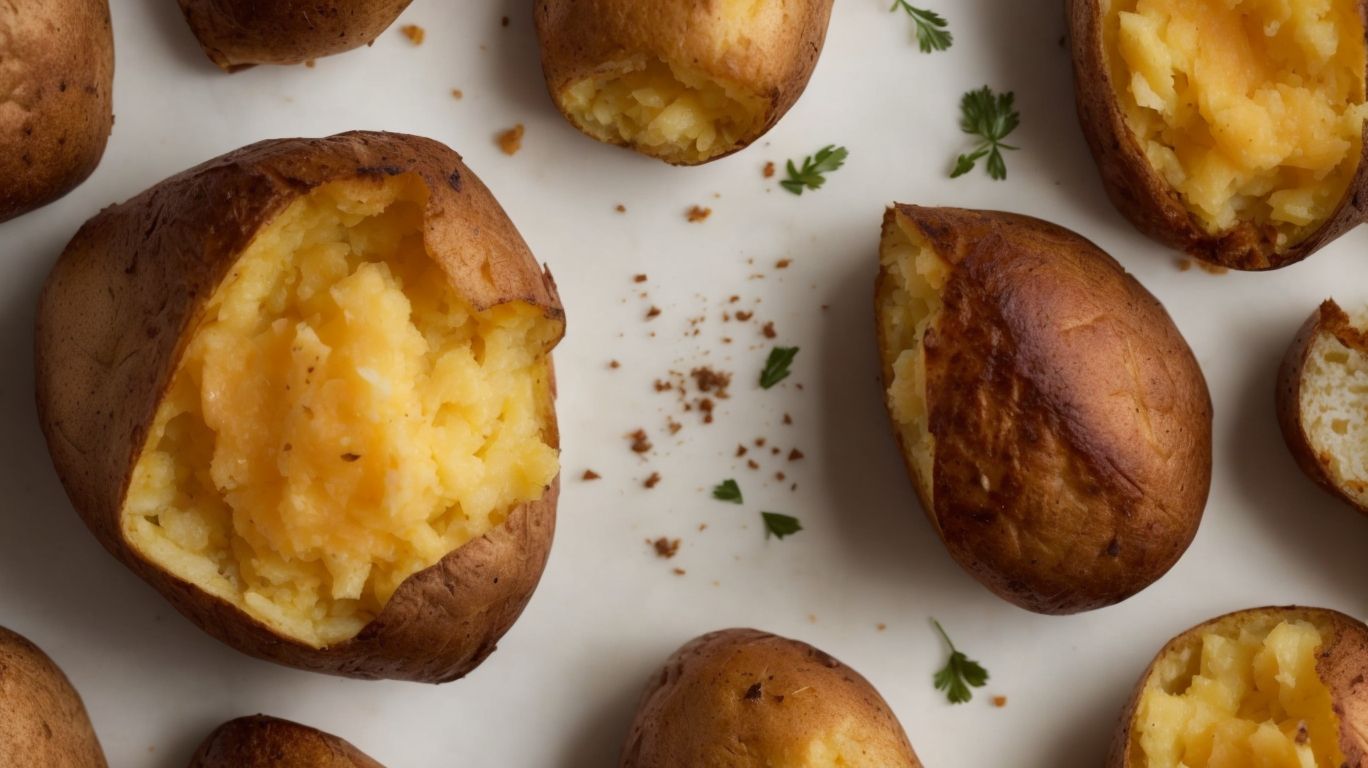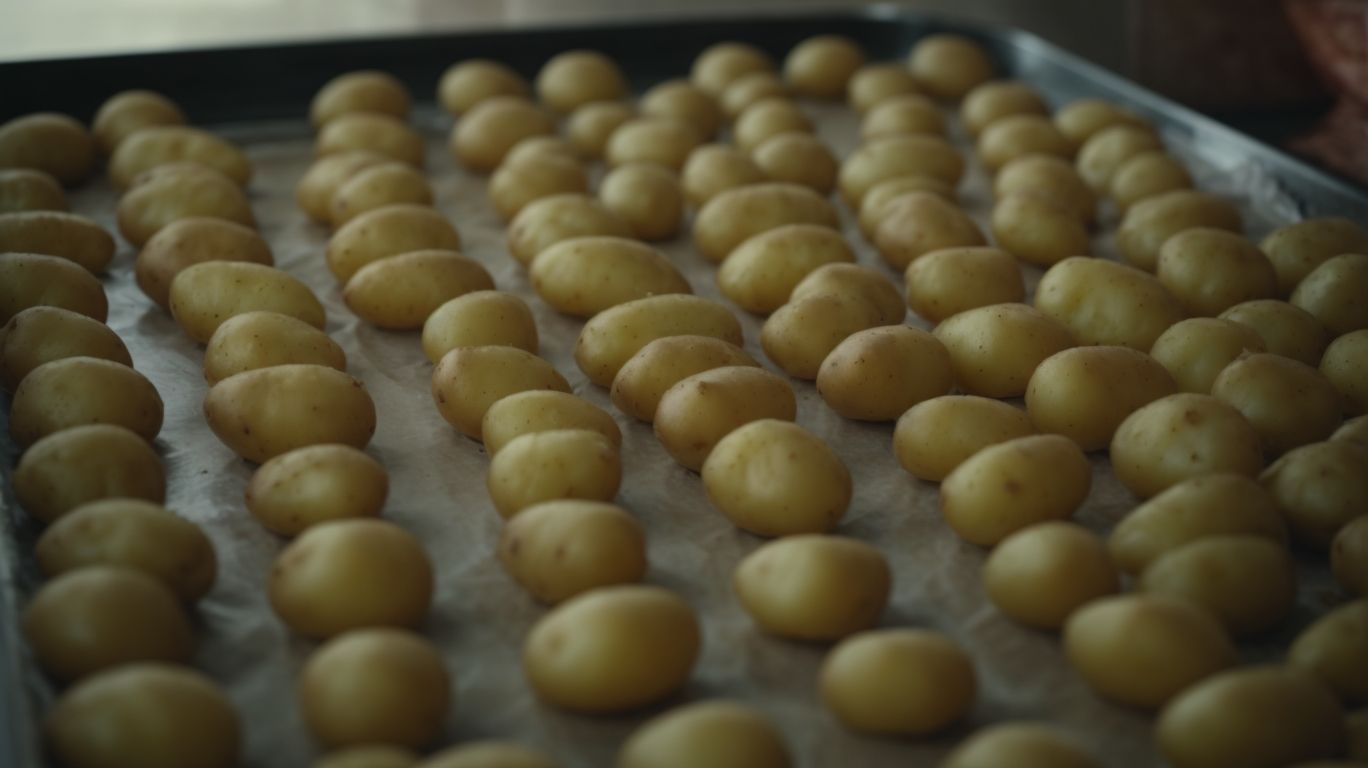How to Bake Potatoes After Boiling?
Are you looking to elevate your baked potato game? Look no further!
We will guide you through the essential first step in baking potatoes – boiling them. Discover why boiling potatoes before baking is crucial and learn how to choose the right potatoes for baking.
Find a step-by-step guide on baking potatoes after boiling, along with tips for achieving perfectly crispy skin and adding delicious flavor.
Stay tuned for all the secrets to creating the perfect baked potatoes!
Key Takeaways:
Boiling Potatoes: The First Step in Baking
Boiling potatoes is a crucial initial step in the baking process, ensuring that the potatoes are cooked through and ready for further preparation.
How to Boil Potatoes?
To boil potatoes effectively, select the appropriate potato variety such as russet, Yukon Gold, or red potatoes, and immerse them in a pot of well-salted boiling water.
For russet potatoes, which are high in starch and ideal for mashing, allow them to boil for about 25-30 minutes until they are tender but not falling apart. Yukon Gold potatoes, with their creamy texture, typically require around 15-20 minutes of boiling. Conversely, red potatoes, known for their waxy consistency, may only need 10-15 minutes.
It is important to ensure the water remains at a consistent boil throughout the cooking process to achieve even cooking. Adding salt to the water not only enhances the flavor of the potatoes but also helps to season them from the inside out.
Why Boil Potatoes before Baking?
Boiling potatoes before baking helps break down the starch content and reduce the sugar content in the potatoes, leading to a better texture and flavor profile after baking.
When you boil potatoes, the starch granules in the cells absorb moisture and swell. This swelling causes the cell walls to break down, resulting in a softer texture. By partially cooking the potatoes through boiling, you initiate the gelatinization process of the starch. This allows the starch molecules to absorb more water and increase viscosity, enhancing the overall creaminess of the potatoes once baked.
Boiling helps to leach out some of the sugar content from the potatoes. Excess sugar can caramelize and darken the potatoes too quickly during baking, resulting in uneven browning and potentially burnt edges. By reducing the sugar content through boiling, you can achieve a more balanced and golden-brown finish on the baked potatoes.
Preparing Potatoes for Baking
Preparing potatoes for baking involves infusing them with aromatic flavors such as garlic, herbs, and spices, enhancing the overall taste profile of the dish.
How to Choose the Right Potatoes for Baking?
Selecting the right potatoes for baking, such as russet, Yukon Gold, or red potatoes, is essential to achieve the desired texture and flavor in the final dish.
Russet potatoes are popular for baking due to their high starch content, which results in a fluffy interior and crispy skin when cooked. On the other hand, Yukon Gold potatoes have a buttery texture and thin skin, ideal for creamy mashed potatoes or scalloped potatoes. Red potatoes, with their waxy texture and thin skin, hold their shape well during baking, making them perfect for roasted potatoes or potato salads.
Choosing the right potato variety based on the desired outcome is crucial in baking. Whether you crave a crispy exterior with a light, fluffy interior, a creamy and rich texture, or potatoes that hold their shape, selecting the appropriate type will significantly impact the success of your dish.
Should You Peel Potatoes Before Baking?
The decision to peel potatoes before baking depends on personal preference and the desired texture of the dish, as leaving the skins on can add a rustic element to the final presentation.
When potatoes are peeled before baking, it can result in a smoother texture, as the skins can sometimes become tough during the cooking process, altering the overall mouthfeel of the dish. Peeled potatoes tend to absorb flavors from seasonings and other ingredients more readily, leading to a more uniform taste profile throughout the dish.
Peeling potatoes can also strip away some of the nutrients present in the skin, such as fiber and certain vitamins. If nutrient content is a concern, leaving the skins on may be a preferable option. The visual appeal of the dish can be enhanced by the contrasting colors and textures that potato skins provide.
What Other Ingredients Can You Add to Baked Potatoes?
Plus potatoes, consider enhancing the flavors of baked potatoes with a variety of herbs, spices, and a drizzle of olive oil for added richness and depth.
Herbs like rosemary and thyme can infuse the potatoes with fragrant earthiness, while spices such as paprika or cayenne pepper can add a kick of heat and complexity to the dish.
Drizzling the potatoes with extra virgin olive oil before baking helps to create a crispy exterior and a creamy interior, elevating the overall texture and mouthfeel of the dish.
Experimenting with a blend of different herbs, spices, and oils can offer a range of flavor profiles, from savory and aromatic to zesty and bold.
Baking Potatoes after Boiling

Credits: Poormet.Com – Dennis Lee
After boiling the potatoes, the next step involves baking them to achieve a crispy and flavorful roast, ensuring they are spread evenly on a baking sheet for optimal results.
Step-by-Step Guide to Baking Potatoes after Boiling
To bake potatoes after boiling, preheat the oven, season the potatoes with desired herbs and spices, and place them on a baking sheet to achieve a crispy and golden roast.
Once you have prepared your seasoned potatoes, it’s time to set your oven temperature to around 425°F (220°C) for optimal roasting.
You can choose various seasonings such as olive oil, salt, pepper, garlic powder, or paprika to enhance the flavor of your potatoes.
Place the baking sheet in the preheated oven and let the potatoes bake for approximately 30-40 minutes until they develop a crunchy outer texture.
How Long Should You Bake Potatoes After Boiling?
The ideal baking time for potatoes after boiling depends on the oven temperature and the desired level of crispiness, typically ranging from 30-45 minutes for a perfectly roasted outcome.
When setting the oven temperature, a range of 400-425°F is recommended for that golden-brown crisp on the outside while ensuring a fluffy interior. Adjusting the roasting preferences, such as placing the potatoes directly on the oven rack for an all-around even heat distribution or using a baking sheet for a slightly softer skin, can impact the end result.
To achieve the desired level of crispiness, flipping the potatoes halfway through the baking time can promote even browning. Coating the potatoes in olive oil or butter before baking adds a layer of moisture that aids in crispy texture development.
How to Tell When Baked Potatoes are Ready?
Determining the readiness of baked potatoes involves assessing the texture and color contrast, looking for a crispy exterior and a fluffy interior that signify a perfectly cooked dish.
Aside from texture and color cues, an additional indicator for fully cooked baked potatoes is the ease of a fork’s insertion into the potato. When it’s done, the potato should offer no resistance and slide in effortlessly. The skin should also have a slightly wrinkled appearance, indicating crispness.
Another crucial point to note is a consistent golden-brown color on the skin, suggesting thorough cooking. A pleasant aroma emanating from the potato is another sure sign that it is ready to be enjoyed.
Tips for Perfectly Baked Potatoes

Credits: Poormet.Com – Jerry Miller
Achieving perfectly baked potatoes involves tips such as ensuring a crispy skin, incorporating flavors for enhanced taste, and benefiting from the health advantages including antioxidants and texture contrast.
How to Get Crispy Skin on Baked Potatoes?
To achieve a crispy skin on baked potatoes, ensure they are evenly spaced on a baking sheet, drizzle with olive oil, and bake at a high temperature for a golden, crunchy exterior.
Preheat your oven to around 425°F (220°C) to create the ideal conditions for achieving that perfect crispiness. The even spacing allows for optimal air circulation, aiding in the potatoes’ uniform cooking. When drizzling with olive oil, remember that it not only enhances the flavor but also helps in achieving a crispy texture by promoting browning. Consider sprinkling a pinch of salt over the potatoes before baking, as this can contribute to the overall texture and taste.
How to Add Flavor to Baked Potatoes?
Enhancing the flavor of baked potatoes can be achieved by incorporating aromatic ingredients such as garlic, rosemary, and a blend of herbs and spices for a delicious and fragrant outcome.
One popular method to infuse baked potatoes with rich flavors is by creating a herb and spice mixture that complements the natural earthy taste of the potatoes. This blend can include staples like thyme, oregano, paprika, and a hint of cayenne pepper for a subtle kick. The key is to ensure that the spices are evenly distributed across the potatoes before baking to ensure a consistent burst of flavor in every bite.
What to Do with Leftover Baked Potatoes?
Transform leftover baked potatoes into delectable dishes by using them in recipes such as potato salads, soups, or hash browns, employing various cooking techniques to reinvent the flavors.
In terms of repurposing leftover baked potatoes, the possibilities are endless. For a refreshing summer dish, try creating a tangy potato salad by mixing diced potatoes with fresh herbs, crunchy veggies, and a zesty dressing. If you’re in the mood for something warm and comforting, why not whip up a creamy potato soup by blending the potatoes with broth, cream, and aromatic spices?
For a hearty breakfast option, consider making crispy hash browns by shredding the potatoes and frying them until golden brown. By experimenting with different ingredients and seasonings, you can enhance the taste and texture of these dishes, creating a delightful culinary experience for your taste buds.
Frequently Asked Questions
How to Bake Potatoes After Boiling?
Question: Can you bake potatoes after boiling them?
Yes, you can bake potatoes after boiling them. In fact, this is a great method to ensure a crispy exterior and fluffy interior.
How to Bake Potatoes After Boiling?
Question: What is the best way to bake potatoes after boiling?
The best way to bake potatoes after boiling is to first parboil them, then coat with oil and seasoning, and bake in the oven at a high temperature.
How to Bake Potatoes After Boiling?
Question: How long should I boil potatoes before baking them?
It is recommended to boil potatoes for about 5-7 minutes before baking to ensure they are partially cooked and ready for the oven.
How to Bake Potatoes After Boiling?
Question: Can I bake potatoes after boiling them in the microwave?
Yes, you can bake potatoes after boiling them in the microwave. Just make sure to prick the potatoes with a fork and microwave for about 5-6 minutes before transferring to the oven.
How to Bake Potatoes After Boiling?
Question: Do I need to peel the potatoes before baking them after boiling?
No, you do not need to peel the potatoes before baking them after boiling. The skin will become crispy and delicious during the baking process.
How to Bake Potatoes After Boiling?
Question: Can I boil and bake potatoes ahead of time?
Yes, you can boil and bake potatoes ahead of time. After boiling, let them cool and store in an airtight container in the fridge for a day or two before reheating in the oven.

